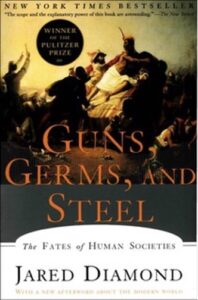Guns, Germs, and Steel

By Jared Diamond
480 pages
First published March 1997
I meant to read this 26 years ago when it was first recommended to me. (The title is a reference to the means by which farm-based societies conquered populations and maintained dominance.) I bought it. Shelved it. And forgot about it.
It came up on my app as a recommended read, and I’ve been listening to it for about a week. It’s probably a good thing that I waited so long to read it, because my interest in the big questions it raises about the world and its disparate cultures was only casual back then.
Now, I have an insatiable appetite for this kind of book. I’m about halfway through it and have been very happy so far. It’s dense with geological, evolutionary, anthropological, and historical facts leading to an understanding of our world today that, while by no means identical to my own view, is complementary.
Critical Reception
In 1998, Guns, Germs, and Steel won the Pulitzer Prize for general nonfiction and the Aventis Prize for Best Science Book. Many critics noted that the large scope of the work made some oversimplification inevitable while still praising it as a very erudite and generally effective synthesis of multiple different subjects.
* “The great thing about Guns, Germs, and Steel is the detail. Jared Diamond starts with [the] proposition that all humans are born with much the same abilities – then proceeds to argue, through meticulous and logical steps, that the playing field of prehistory was anything but level.” (The Guardian)
* “Guns, Germs, and Steel and Collapse [its sequel] represent one of the most significant projects embarked upon by any intellectual of our generation.” (The New York Times)
* “Artful, informative, and delightful.” (New York Review of Books)
A documentary based on the book, produced by the National Geographic Society, was broadcast on PBS in July 2005. Click here to watch Part 1.
And for a quick, four-minute cartoon summary of the book, click here.
